Matcha
Optimal Matcha to Water Ratio for Perfect Tea
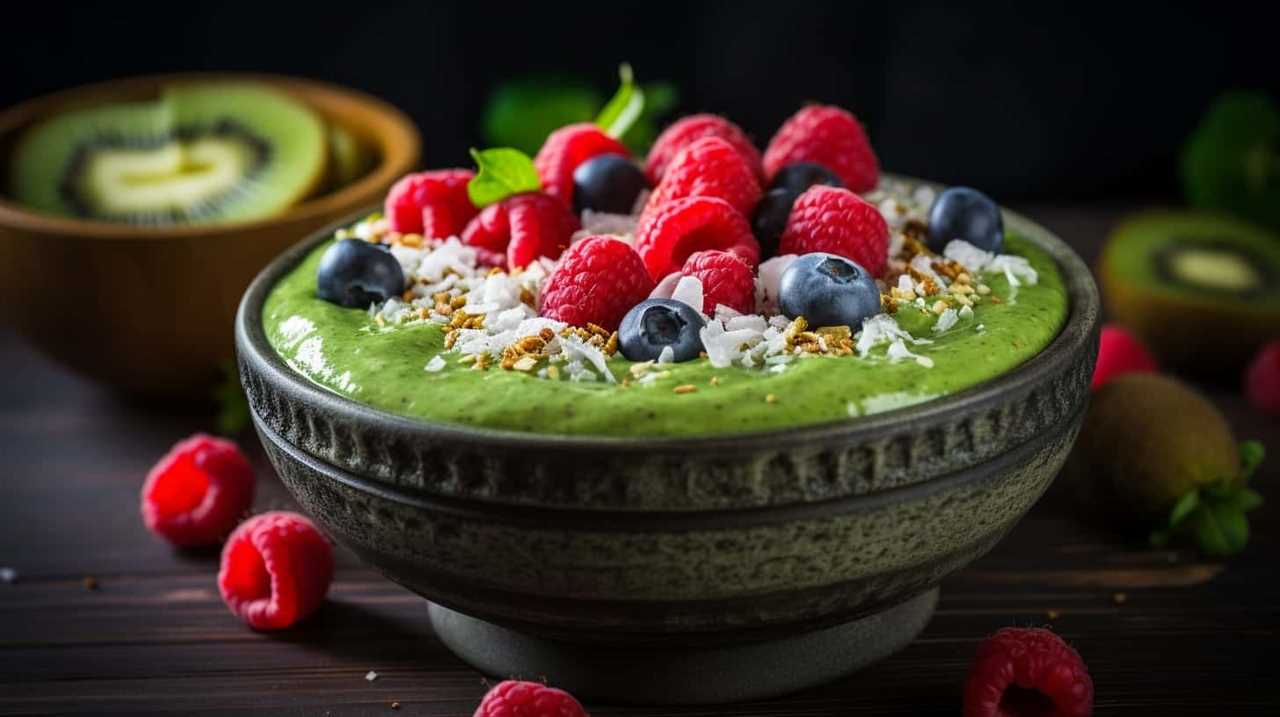
When it comes to matcha, the adage ‘measure twice, cut once’ holds true. Understanding the matcha to water ratio is essential for achieving the perfect cup of this vibrant green tea. In our pursuit of mastery, we recognize the importance of getting this ratio right.
Different types of matcha require different ratios, and experimenting with them allows us to find our personal preference. We’ll also explore how to adjust the ratio for a refreshing iced matcha and how to incorporate matcha into various recipes.
By avoiding common mistakes and following our recommendations, we can elevate our matcha experience to new heights. So, let’s delve into the world of matcha to water ratio and unlock the full potential of this exquisite tea.
Key Takeaways
- The matcha to water ratio greatly impacts the flavor and overall experience of matcha tea.
- Different types of matcha have unique characteristics and flavor profiles, so understanding the grades helps in choosing the right matcha for desired taste and purpose.
- Experimenting with different ratios and steeping times allows you to find your personal preference for matcha strength.
- Proper measurement, whisking, and water temperature are key factors in achieving a flavorful and well-balanced cup of matcha tea.
Understanding the Basics
To understand the basics of matcha to water ratio, we need to consider the amount of matcha powder and water that we should use. Matcha brewing techniques play a crucial role in achieving the perfect balance of flavors.

When it comes to matcha, the flavor profiles are diverse, ranging from earthy and vegetal to sweet and creamy. The ratio of matcha to water greatly influences these flavor profiles. A higher matcha to water ratio will result in a stronger and bolder taste, whereas a lower ratio will produce a milder and more delicate flavor. It’s important to find the right balance that suits your personal preference.
Understanding the impact of matcha to water ratio is essential in creating a harmonious and enjoyable matcha experience. Now, let’s delve into the importance of ratio in further detail.
The Importance of Ratio
Let’s now explore why the ratio of matcha to water is so important in creating the perfect cup of matcha. Understanding measurements and achieving balance are crucial elements in the art of matcha preparation. The ratio determines the strength, flavor, and overall experience of the tea. Too much matcha and the taste can become overpowering and bitter. Too little and the tea may lack depth and complexity. Achieving the right balance is key.
To help you better understand the importance of ratio, let’s take a look at the following table:
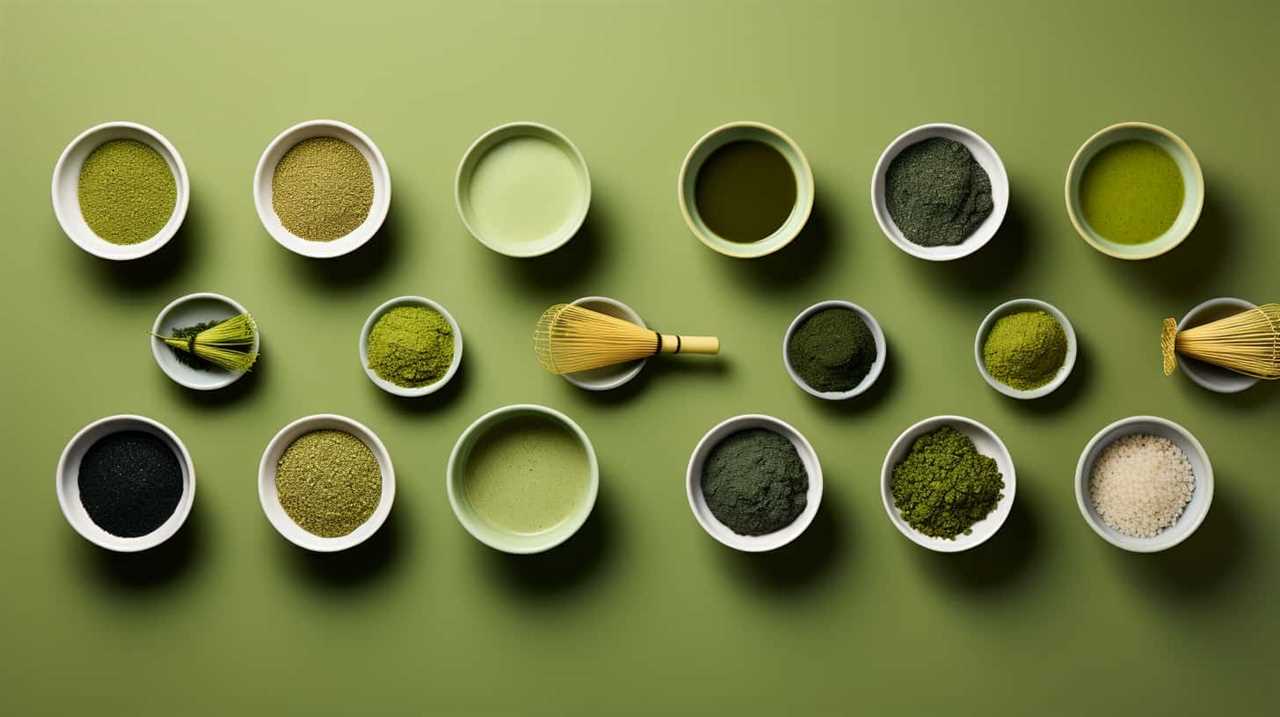
| Matcha to Water Ratio | Strength | Flavor | Experience |
|---|---|---|---|
| 1:30 | Light | Delicate | Subtle |
| 1:20 | Medium | Balanced | Smooth |
| 1:15 | Strong | Robust | Bold |
| 1:10 | Intense | Bitter | Powerful |
As you can see, adjusting the ratio can greatly impact the characteristics of your matcha. Experiment with different ratios to find your preferred taste profile. Remember, the perfect cup of matcha is all about finding the right balance.
Different Types of Matcha
Now, let’s delve into the various types of matcha available. Matcha comes in different grades, each with its own unique characteristics and flavor profiles.
The highest grade is ceremonial matcha, which is made from the youngest tea leaves and is known for its vibrant green color, smooth texture, and delicate, sweet flavor. This grade is best enjoyed on its own or in traditional tea ceremonies.
Next is premium matcha, which has a slightly stronger flavor and is often used in cooking and baking.
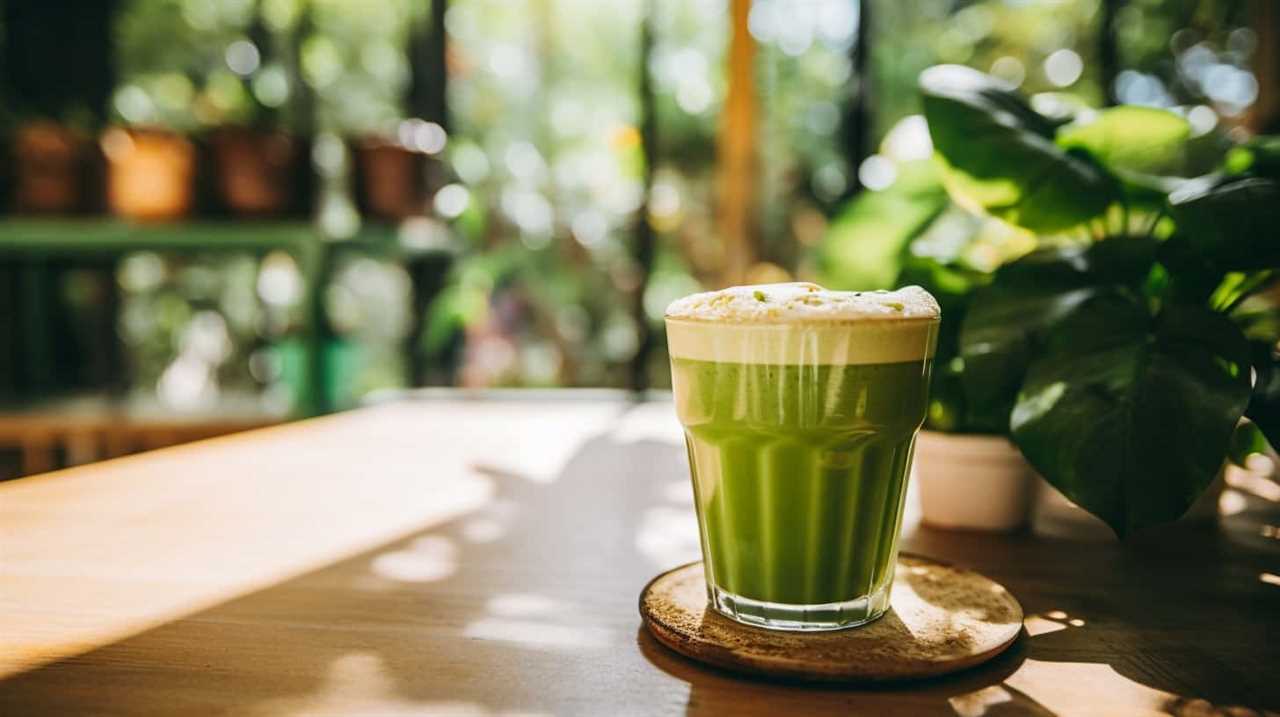
Lastly, there’s culinary matcha, which has a more robust flavor and is commonly used in recipes that require a stronger matcha taste.
Understanding the different matcha grades and their flavor profiles will allow you to choose the right matcha for your desired taste and purpose.
Experimenting With Ratios
As we delve into the topic of experimenting with ratios, it’s important to consider the ideal matcha to water ratio for the perfect cup of matcha. Here are four key points to keep in mind when it comes to finding the right balance:
- Start with a 1:1 ratio: For a traditional cup of matcha, aim for equal parts matcha powder and water. This will give you a strong and bold flavor.
- Adjust to your taste: If you prefer a milder taste, you can increase the water to matcha ratio. Experiment with different combinations until you find your preferred balance.
- Use measuring tools: To ensure accuracy, use a bamboo matcha scoop or a teaspoon to measure the amount of matcha powder. Similarly, use a kitchen scale or a measuring cup to measure the water.
- Consider the ideal brewing time: Typically, whisking matcha for about 20-30 seconds will yield a smooth and frothy cup. However, you can adjust the whisking time to achieve the desired consistency.
By understanding the ideal matcha to water ratio and exploring different combinations, you can begin to find your personal preference for the perfect cup of matcha.

Now, let’s move on to the next section and delve into the art of finding that perfect balance.
Finding Your Personal Preference
When it comes to finding your personal preference for matcha strength, there are a few key points to consider.
First, it’s important to experiment with different ratios of matcha to water to find the ideal strength that suits your taste buds.
Whether you prefer a stronger, more robust flavor or a milder, smoother taste, adjusting the ratio can help tailor your matcha experience to your liking.

Ultimately, it’s all about finding the perfect balance that satisfies your unique taste preferences.
Ideal Matcha Strength
To find our ideal matcha strength, we experiment with different matcha to water ratios. Achieving the perfect balance is crucial to fully enjoy the benefits of matcha. Here are four key factors to consider when adjusting the brewing time and finding your personal preference:
- Amount of matcha: Start with 1 teaspoon of matcha per 8 ounces of water. Adjust the amount based on the desired strength.
- Water temperature: Use water heated to around 175°F (80°C). Higher temperatures can result in a bitter taste, while lower temperatures may produce a weaker flavor.
- Whisking technique: Vigorously whisk the matcha in a zigzag motion until a frothy layer forms on the surface. This helps to evenly distribute the matcha and enhance its flavor.
- Tasting and adjusting: After preparing your matcha, take a sip and assess the strength. If it’s too weak, add more matcha; if it’s too strong, add more water. Keep experimenting until you find your perfect matcha strength.
Experimenting With Ratios
We experiment with different matcha to water ratios to find our personal preference and achieve the perfect balance of flavors. Finding the perfect balance is essential for a satisfying cup of matcha. The ratio determines the intensity of the flavor and the overall experience.
When experimenting with ratios, it’s crucial to consider the impact of steeping time as well. Steeping time affects the strength and bitterness of the matcha. A longer steeping time can result in a stronger and more bitter flavor, while a shorter steeping time can yield a milder taste.
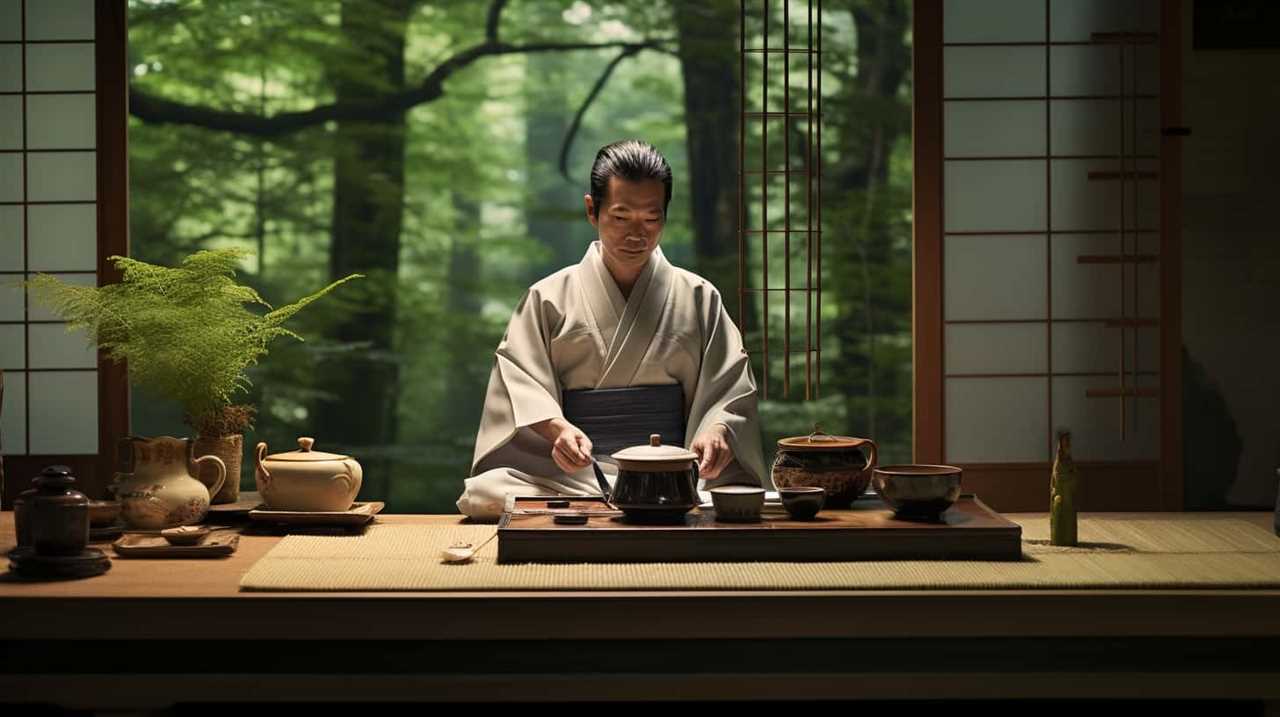
Tailoring to Taste Preferences
As we tailor our matcha to water ratio to our personal taste preferences, we can achieve the perfect balance of flavors that we’ve been experimenting with. Finding our preferred matcha flavor requires some trial and error, but with the right tailoring techniques, we can customize the taste to our liking.
Here are four tips to help you discover your ideal matcha to water ratio:
- Start with a 1:1 ratio: Begin by using equal parts matcha and water. This will give you a strong and robust flavor.
- Adjust the ratio: If the matcha is too bitter or strong, increase the water ratio. Conversely, if it’s too weak, add more matcha.
- Experiment with temperature: Matcha’s flavor can change depending on the water temperature. Try different temperatures to find the one that brings out the best flavors for you.
- Consider additives: If you prefer a sweeter or creamier matcha, you can add sweeteners like honey or milk to enhance the flavor.
Tips for Measuring Matcha
When it comes to measuring matcha, there are a few key points to keep in mind.
Firstly, achieving the ideal consistency is crucial for a smooth and enjoyable cup of matcha.
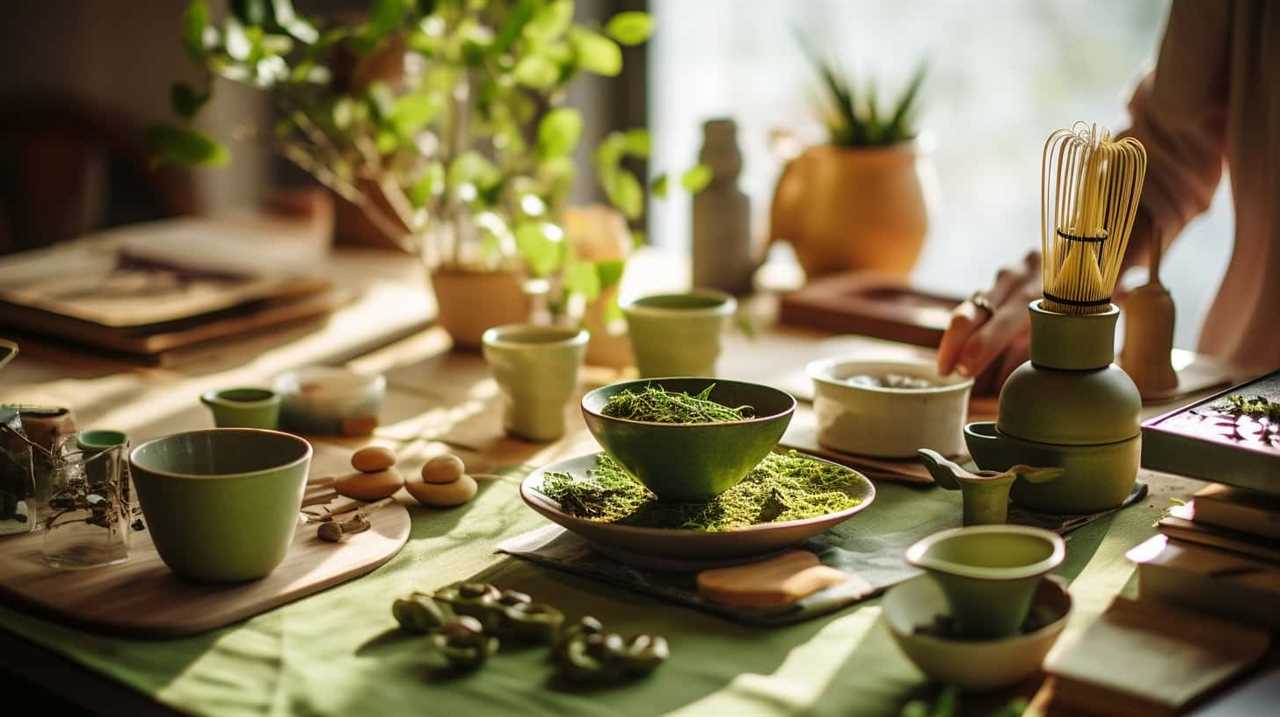
Secondly, avoiding clumpy matcha is important for a pleasant drinking experience.
Lastly, finding the right balance between flavor and strength is essential to tailor the matcha to your personal preference.
Ideal Matcha Consistency
To achieve the ideal matcha consistency, we recommend carefully measuring the matcha powder. Here are four tips for achieving a smooth matcha:
- Use a bamboo matcha scoop: This traditional utensil allows you to measure the perfect amount of matcha powder. One scoop is typically equivalent to 1 gram.
- Sift the matcha: Sifting helps break up any clumps and ensures a smooth and even consistency. Use a fine-mesh sieve to remove any lumps or impurities.
- Gradually add water: Slowly pour hot water over the matcha powder while whisking in a gentle, zigzag motion. This helps to prevent clumping and ensures a smooth mixture.
- Whisk with a bamboo whisk: Using a traditional bamboo whisk, called a chasen, helps create a frothy and velvety texture. Whisk vigorously in a ‘W’ motion until the matcha becomes frothy and well-blended.
Avoiding Clumpy Matcha
To avoid clumpy matcha, we can ensure an even consistency by carefully measuring the matcha powder. Avoiding clumps is an essential step in troubleshooting matcha problems and achieving a smooth and enjoyable cup of matcha.
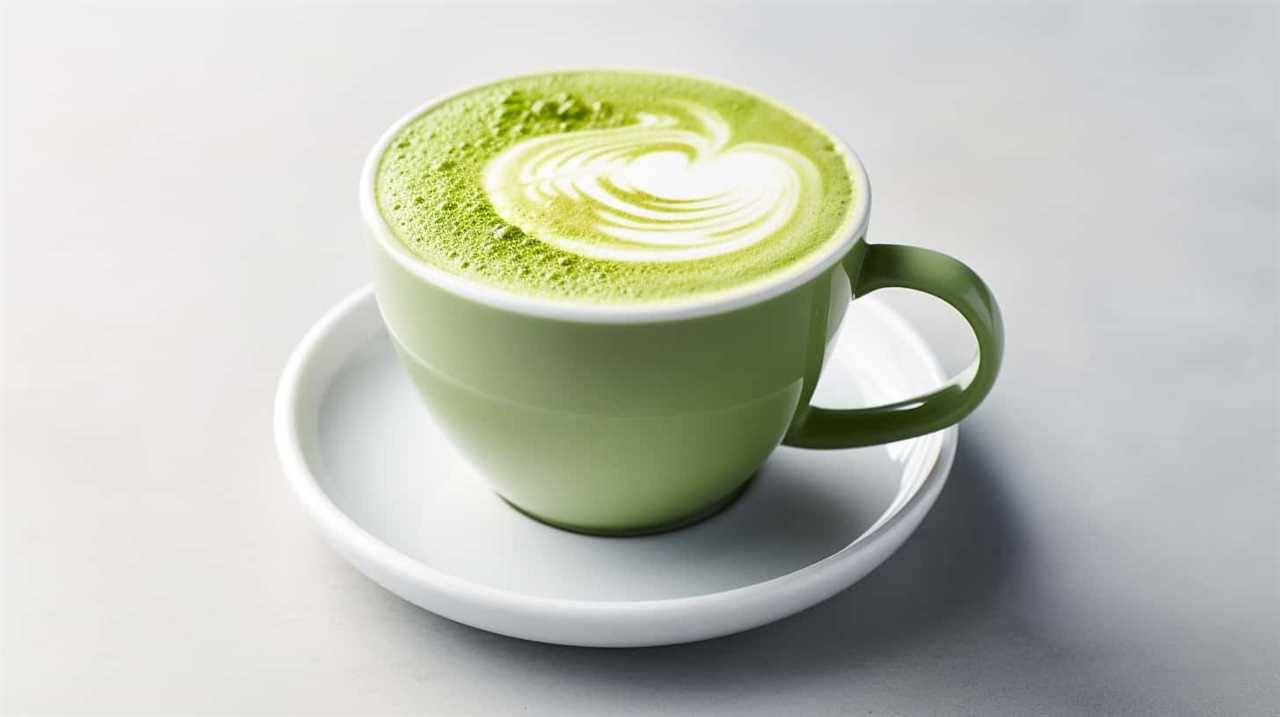
When measuring matcha, it’s crucial to use a proper measuring tool, such as a bamboo scoop or a teaspoon, to ensure accuracy. Gently sift the matcha powder into a bowl to break up any clumps that may have formed during storage. This step is particularly important if your matcha powder has been sitting for a while.
By taking the time to measure your matcha properly and sift it before whisking, you can prevent clumps and achieve a velvety smooth texture in your matcha.
Now, let’s move on to balancing flavor and strength in the next section.
Balancing Flavor and Strength
For achieving a well-balanced flavor and strength in our matcha, it’s important to use the appropriate matcha to water ratio. Balancing flavor profiles and achieving the perfect matcha texture requires precision and mastery.

Here are four tips to help you measure matcha effectively:
- Start with a 1:2 ratio: Begin by using 1 teaspoon of matcha for every 2 ounces of water. This ratio provides a good starting point for a balanced taste.
- Adjust to taste: Experiment with different ratios to find the flavor and strength that suits your preferences. Gradually increase or decrease the matcha to water ratio until you achieve the desired balance.
- Use a bamboo whisk: Whisking the matcha vigorously with a bamboo whisk will help create a smooth and frothy texture, enhancing the overall experience.
- Consider the quality of matcha: Higher quality matcha may require less water to maintain its flavor intensity. Be mindful of the quality of matcha you’re using and adjust the ratio accordingly.
The Role of Water Temperature
Water temperature plays a crucial role in determining the flavor and quality of matcha. The effects of water temperature on matcha can be seen through the various brewing techniques. To help you understand the importance of water temperature, here is a table outlining the recommended water temperatures for different matcha preparations:
| Water Temperature | Matcha Preparation |
|---|---|
| 70°C (158°F) | Usucha (thin tea) |
| 80°C (176°F) | Koicha (thick tea) |
| 85°C (185°F) | Matcha Latte |
| 90°C (194°F) | Iced Matcha |
| 100°C (212°F) | Cooking |
Adjusting Ratios for Iced Matcha
Now that we’ve explored the role of water temperature in matcha preparation, let’s delve into adjusting ratios for iced matcha.
Adjusting serving size and incorporating matcha into drinks can create refreshing and delicious beverages. Here are four tips to help you achieve the perfect iced matcha:
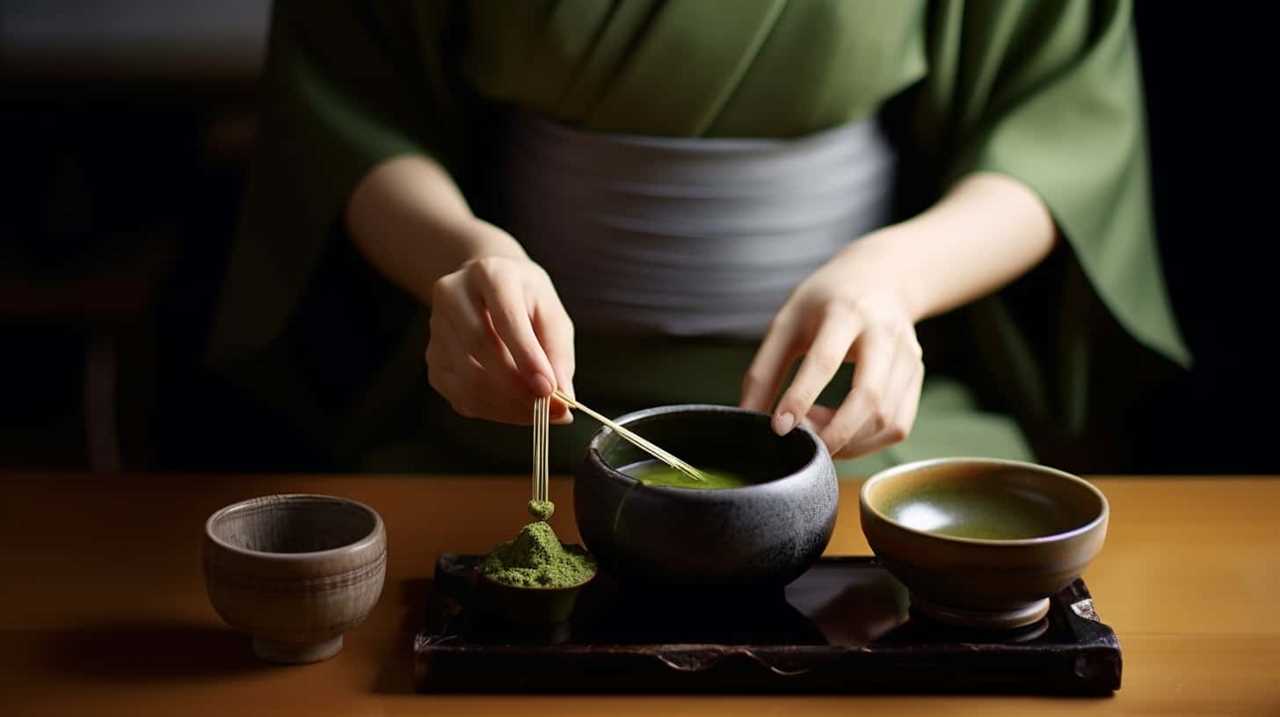
- Increase the amount of matcha powder: Since cold liquids tend to dilute the flavor, adding a little extra matcha will ensure a bold and vibrant taste.
- Use less water: To balance the increased matcha powder, reduce the amount of water you use. This will prevent the drink from becoming too diluted.
- Add sweeteners sparingly: Iced matcha can be naturally sweet, so start with a small amount of sweetener and adjust to your taste.
- Experiment with different liquids: Instead of using plain water, try incorporating milk, almond milk, or coconut water to add richness and enhance the flavor.
By following these tips, you can enjoy a refreshing and well-balanced iced matcha drink.
Now, let’s explore how to use matcha in various recipes.
Using Matcha in Recipes
When it comes to using matcha in recipes, there are a few key points to keep in mind.
First, it’s important to achieve the optimal matcha concentration to ensure the right balance of flavor and color in your dishes.

Additionally, using matcha can enhance the flavor profiles of various recipes, adding a unique and vibrant taste.
Lastly, don’t be afraid to experiment with matcha in different recipes to discover new and exciting culinary creations.
Optimal Matcha Concentration
To achieve the optimal matcha concentration in recipes, we frequently experiment with different ratios of matcha to other ingredients. Finding the right balance is crucial to ensure that the matcha flavor shines through without overpowering the other components of the dish.
Here are four key considerations when determining the optimal matcha concentration:
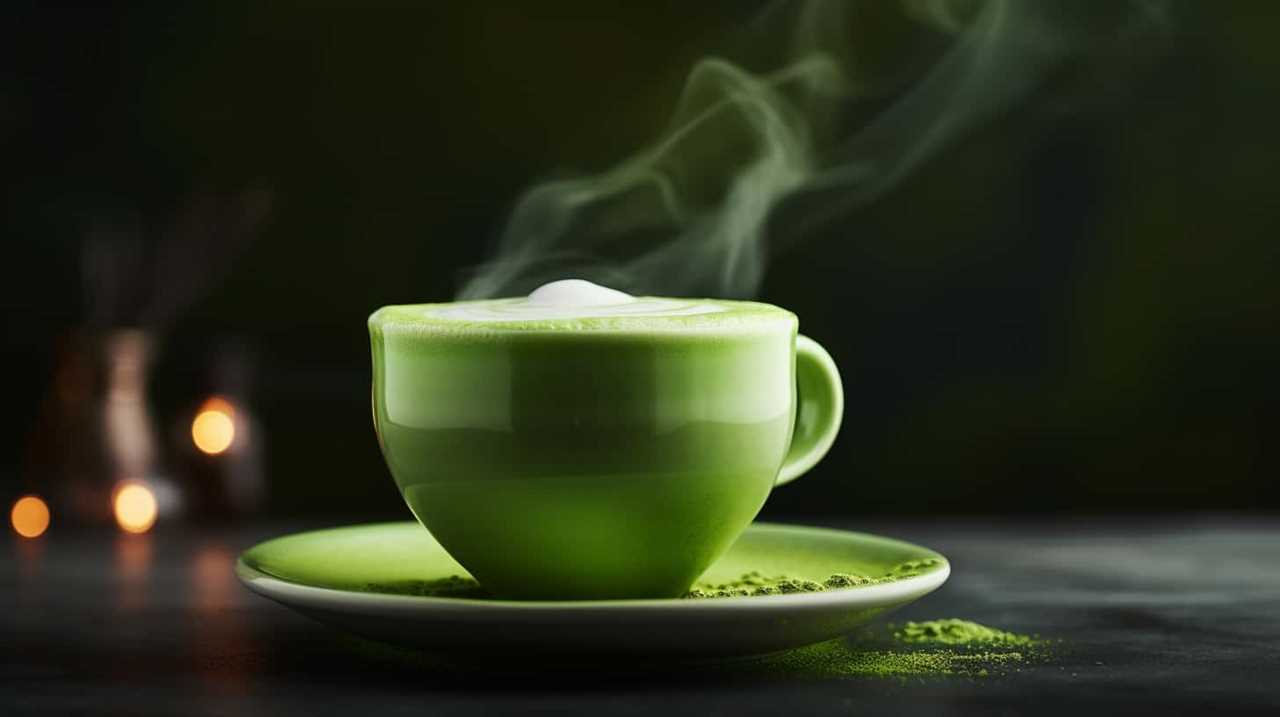
- Recipe Type: The type of recipe you’re working with will greatly influence the ideal matcha concentration. For delicate desserts like macarons or custards, a lighter concentration is often preferred. On the other hand, robust recipes like matcha lattes or ice creams can handle a stronger matcha flavor.
- Personal Preference: Everyone’s taste buds are unique, so it’s important to consider personal preference when determining the optimal matcha concentration. Some individuals may prefer a more subtle matcha flavor, while others enjoy a bolder taste.
- Desired Intensity: Consider the intensity of matcha flavor you want to achieve in the final dish. Adjust the matcha concentration accordingly to reach the desired level of richness and depth.
- Ingredient Compatibility: Take into account the other ingredients in the recipe and how they interact with matcha. Certain ingredients, such as sweeteners or dairy, can mellow or enhance the matcha flavor. Experimenting with different ratios will help achieve the perfect balance.
Enhancing Flavor Profiles
In this article, we’ll explore how we can enhance flavor profiles by incorporating matcha into various recipes. Matcha isn’t only a vibrant and nutritious beverage but also a versatile ingredient that can elevate the taste of both sweet and savory dishes.
When using matcha in recipes, it’s essential to understand the role it plays in enhancing aroma and flavor extraction. The rich and earthy notes of matcha can complement and intensify other ingredients, creating a harmonious blend of flavors.
Whether you’re baking matcha-infused cookies or adding it to a creamy pasta sauce, the possibilities are endless. By experimenting with matcha in different recipes, we can unlock its full potential and discover exciting new flavor combinations.
Now, let’s delve into the art of experimenting with matcha.

Experimenting With Matcha
As we delve into the exciting world of matcha experimentation, let’s explore the endless possibilities of using matcha in various recipes. Here are four experimenting techniques to help you unlock the full potential of matcha and create delightful flavor profiles:
- Baking with Matcha: Add matcha to your favorite baked goods, like cookies, cakes, or muffins, to infuse a unique earthy and slightly bitter taste.
- Matcha Lattes: Create a creamy and frothy matcha latte by whisking matcha powder with hot milk and a sweetener of your choice. Experiment with different milk alternatives and flavorings to find your perfect combination.
- Matcha Smoothies: Blend matcha powder with fruits, yogurt, and a liquid of your choice to prepare a refreshing and energizing matcha smoothie. Play around with different fruit combinations to discover exciting flavor profiles.
- Matcha Desserts: Elevate your desserts with matcha by incorporating it into ice creams, puddings, or custards. The earthy and vibrant flavor of matcha adds a unique twist to traditional desserts.
Now that we’ve explored the endless possibilities of using matcha in recipes, let’s transition into the next section to discuss common mistakes to avoid when working with matcha.
Common Mistakes to Avoid
By neglecting to properly measure the matcha to water ratio, we risk making common mistakes that can affect the quality of our matcha tea. Finding the right balance is crucial in achieving the perfect cup of matcha.
One common mistake is using too much matcha powder, resulting in a bitter and overpowering taste. On the other hand, using too little matcha powder can make the tea taste weak and lack the vibrant green color.
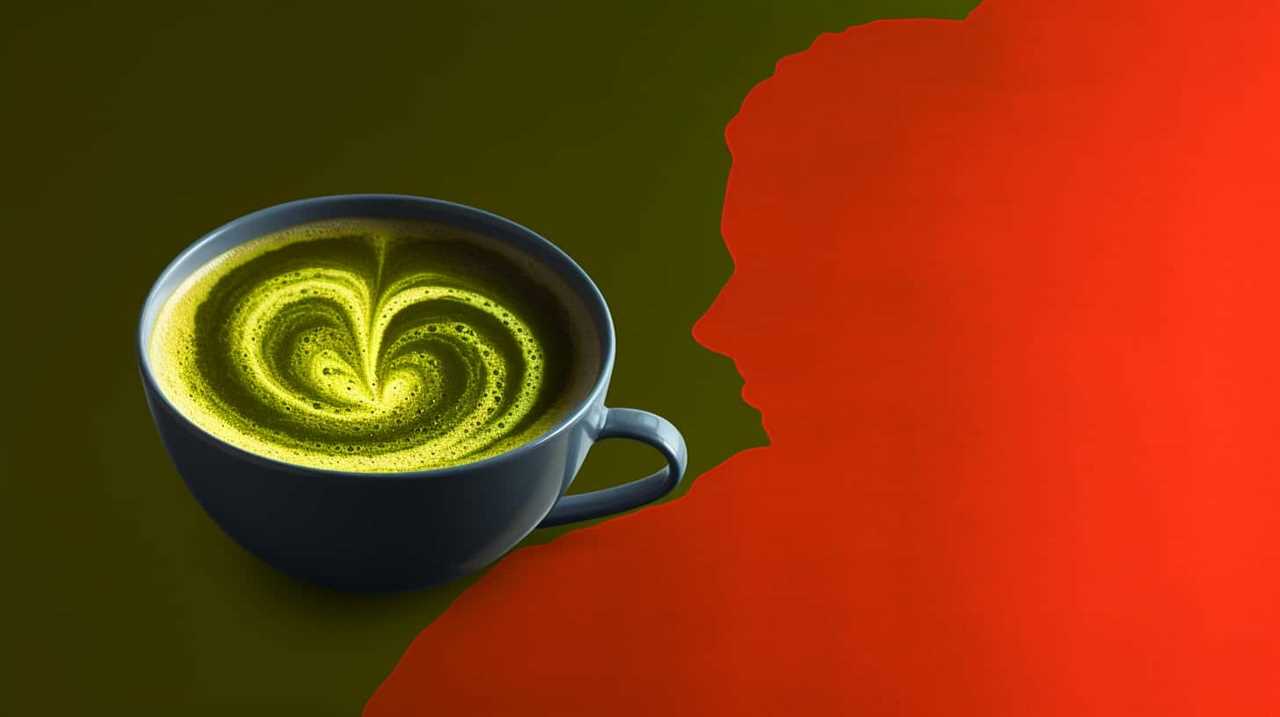
Another common issue is using water that’s too hot. Matcha is best prepared with water that’s around 175°F to 180°F, as water that’s too hot can scorch the matcha and produce a bitter taste.
Troubleshooting these common issues and being mindful of the matcha to water ratio will help us achieve a flavorful and well-balanced cup of matcha tea.
Final Thoughts and Recommendations
To ensure the best matcha tea experience, we recommend being mindful of the matcha to water ratio and following these guidelines:
- Finding the perfect balance: Experiment with different ratios to find the taste and texture that suits your preference. Start with a 1:1 ratio of matcha to water and adjust accordingly.
- Understanding matcha grades: Different grades of matcha have varying flavor profiles and intensities. Higher grades are generally smoother and sweeter, while lower grades may have a more astringent taste. Consider the grade of matcha you’re using when determining the ideal ratio.
- Whisking technique: Use a bamboo whisk to create a frothy and well-incorporated matcha. Whisk vigorously in a zigzag motion to ensure the powder is fully dissolved in the water.
- Temperature and water quality: Use water that’s around 175°F (80°C) to preserve the delicate flavors of matcha. Avoid using boiling water, as it can result in a bitter taste. Additionally, use filtered water to enhance the overall taste of your matcha.
Frequently Asked Questions
Can I Use Any Type of Water to Make Matcha?
We can use different types of water to make matcha, but the water-to-matcha ratio may vary. It’s important to consider the flavor profile you desire. Experiment with different ratios to find the perfect balance for your matcha drinks.
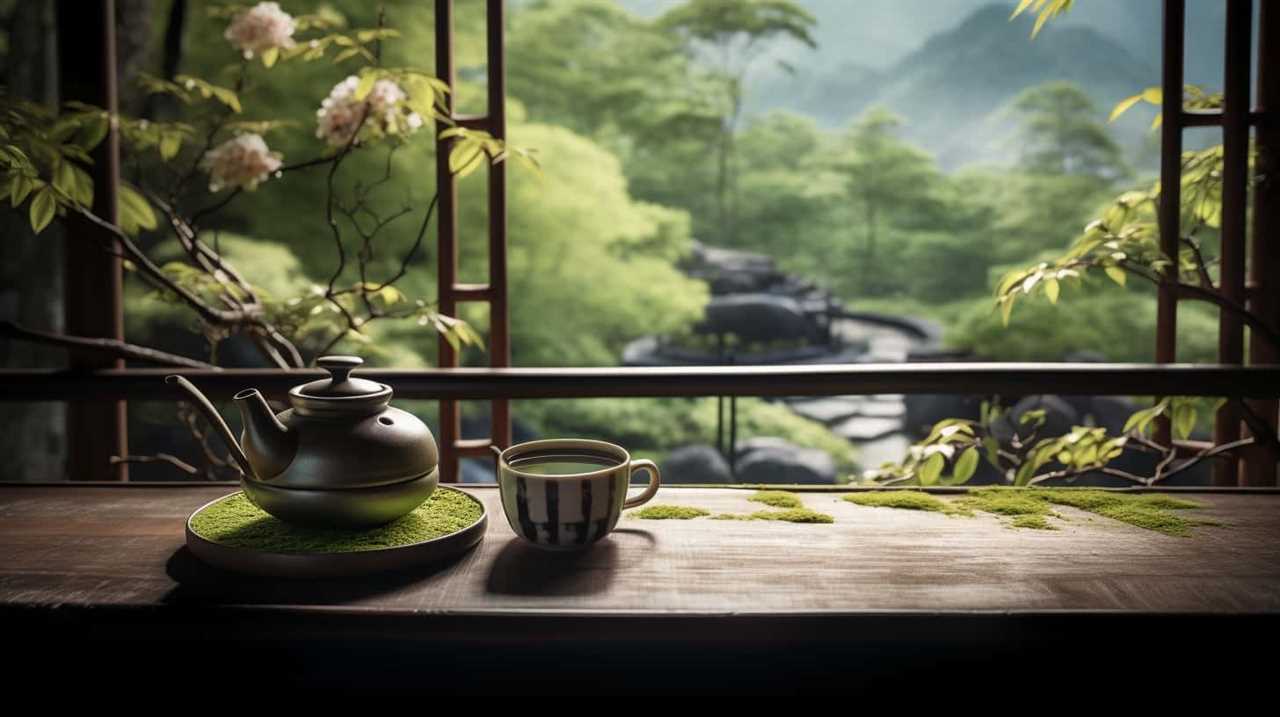
How Does the Water Temperature Affect the Taste of Matcha?
Water temperature effects the taste of matcha significantly. The optimal water temperature is around 175°F (80°C) to 185°F (85°C). Higher temperatures can make matcha bitter, while lower temperatures may result in a weak flavor.
What Are Some Common Recipes That Use Matcha?
We’ve discovered some amazing matcha recipes! From refreshing matcha smoothies to indulgent matcha latte variations, there’s no shortage of delicious ways to enjoy this vibrant green tea powder. Let’s dive into the world of matcha culinary mastery!
What Are Some Mistakes to Avoid When Measuring Matcha?
When measuring matcha, it’s crucial to use proper measuring techniques and a whisk. Avoid the mistake of eyeballing the amount or using too much matcha, as it can result in a bitter taste and uneven texture.
Can I Adjust the Matcha to Water Ratio for Different Types of Matcha Drinks?
Yes, we can adjust the matcha to water ratio for different types of matcha drinks. By varying the amount of matcha powder and water, we can control the strength of the matcha and create alternative matcha drinks with unique flavors.
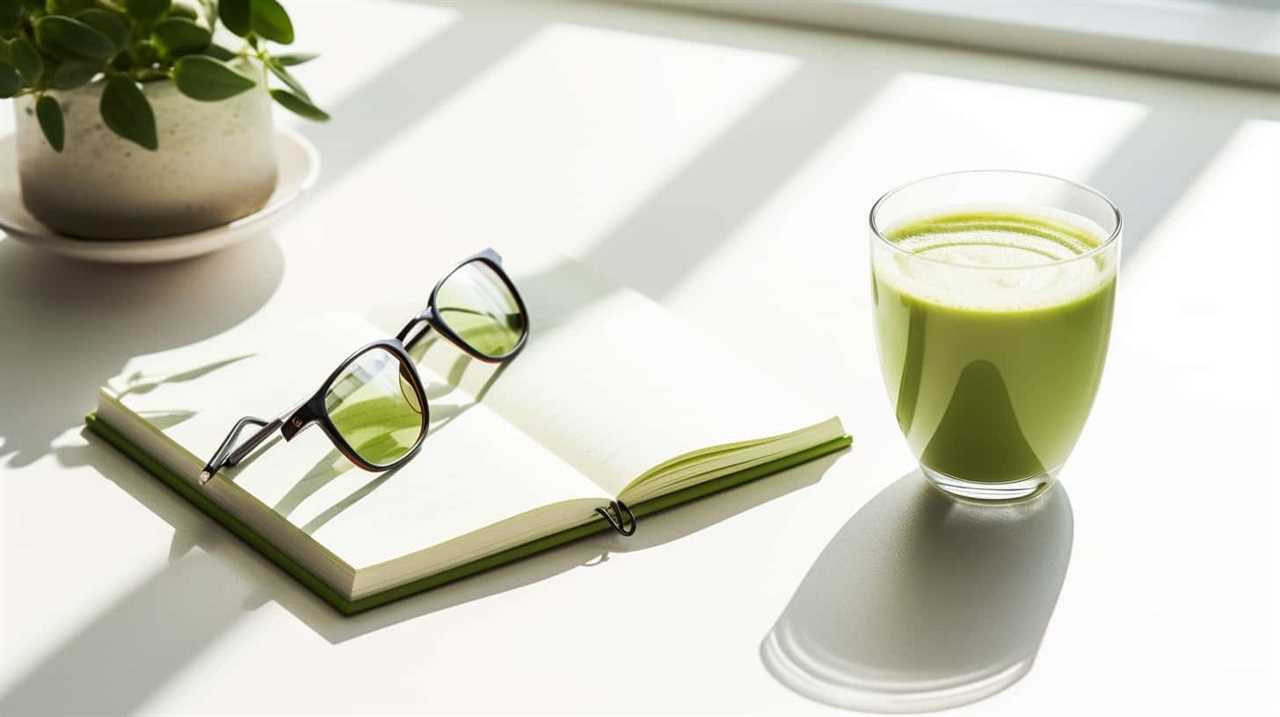
Conclusion
In conclusion, finding the perfect matcha to water ratio is key to achieving the best flavor and texture in your matcha drinks and recipes. Just like a symphony conductor carefully balances each instrument to create a harmonious melody, experimenting with different ratios allows you to fine-tune your matcha experience.
Whether you prefer a stronger or milder taste, adjusting the ratio can make all the difference. So grab your whisk and start exploring the wonderful world of matcha with confidence and creativity!
Justin is a seasoned author, coffee and tea enthusiast, and an essential member of the Cappuccino Oracle team. With a keen appreciation for the complexities of coffee, coffee alternatives, and tea, Justin has dedicated his professional career to exploring these realms and sharing his insights with readers worldwide.
Justin’s immersion in the world of coffee, coffee alternatives, and tea began at a young age, kindling a passion that extended beyond mere consumption. This love for these beverages led him to combine his talent for writing with his devotion to coffee and tea, bringing him to Cappuccino Oracle as a dedicated author.
Matcha
Unveiling The Mysteries Of Matcha: Insights On Its Origins, Production, And Quality

Have you ever been curious about the mysteries behind the rich and natural flavors of matcha? If so, get ready to join me on an adventure as we uncover the secrets of matcha, delving into its origins, production, and quality.
As a lover of all things tea, I have delved deep into the world of matcha, immersing myself in its rich history and intricate production process. From the shade-grown tea leaves to the meticulous grinding technique, every step is a labor of love that culminates in the velvety smooth powder we know as matcha.
Join me as we unravel the secrets behind this ancient Japanese tradition and discover why quality is key when indulging in this verdant elixir. We’ll explore the nuances of flavor, the importance of sourcing, and even delve into the fascinating world of other tea varieties.
So grab a cup, sit back, and let’s dive into the captivating world of matcha.
Key Takeaways
- Matcha tea is made from powdered green tea leaves and has a long and labor-intensive production process.
- Premium matcha is made from the first harvest in early spring, using the top 3 sprouts of the tea plant and ground tencha leaves.
- Cheaper matchas may skip some steps in the production process and are more suitable for matcha lattes.
- High-quality matcha is recommended for sparing consumption, as it has a smoother flavor and more health benefits compared to cheaper matchas.
What is matcha?
I’ve learned that matcha is a powdered green tea made from special tea leaves that are shaded before harvest, and it has a long and labor-intensive production process.
There are different types of matcha available, but the premium matcha is made from the first harvest in early spring, using only the top 3 sprouts of the tea plant. The leaves are then steamed, dried, and have their stems removed before being ground into a fine powder using a specialized mill made of granite.
It’s important to note that high-quality matcha is recommended for sparing consumption, as it has a complex production process that results in a smooth flavor. Matcha also offers various health benefits, such as being rich in antioxidants, boosting metabolism, and improving mental alertness.
Production process
The matcha production process involves shading the tea leaves before harvest and selecting the top three sprouts of the tea plant for premium matcha. Shading is a technique used to enhance the flavor and quality of the tea leaves. By covering the tea plants with shade, the leaves produce more chlorophyll and amino acids, resulting in a vibrant green color and a rich, umami taste.
After the shading period, only the top three sprouts of the tea plant are carefully handpicked for premium matcha. These selected leaves, known as tencha leaves, are then steamed, dried, and have their stems removed.
Finally, the tencha leaves are ground into a fine powder using a specialized granite mill. This process results in the smooth and concentrated matcha powder that we enjoy.
Quality and consumption
Let me tell you, indulging in high-quality matcha is like sipping a vibrant green elixir that awakens your taste buds and nourishes your body with its rich flavor and numerous health benefits. Matcha’s health benefits are truly remarkable. Packed with antioxidants, vitamins, and minerals, matcha is known to boost metabolism, enhance focus and concentration, and strengthen the immune system.
But not all matcha is created equal. Different grades of matcha exist, ranging from ceremonial grade to culinary grade. Ceremonial grade matcha is made from the highest quality tencha leaves and has a smooth, vibrant green color and a delicate, umami flavor. It is best enjoyed on its own, whisked with hot water.
On the other hand, culinary grade matcha is more affordable and is suitable for making matcha lattes, smoothies, and baked goods. Although it may have a slightly bitter taste and a duller color, it still provides health benefits.
So, whether you choose to indulge in high-quality ceremonial grade matcha or opt for the more affordable culinary grade, incorporating matcha into your routine is a delicious way to reap its health benefits.
Frequently Asked Questions
What are some popular ways to enjoy matcha besides drinking it as tea?
Besides drinking matcha as tea, some popular ways to enjoy it include indulging in matcha desserts like matcha ice cream, matcha cake, and matcha cookies. Additionally, matcha smoothies are a refreshing and healthy option.
Are there any specific health benefits associated with consuming matcha?
I’m no expert, but matcha is said to have potential health benefits. Some claim it can aid in weight loss due to its high antioxidant content and metabolism-boosting properties. However, more research is needed to confirm these claims.
How does the quality of matcha affect its flavor and overall experience?
The quality of matcha directly affects its flavor and overall experience. Higher quality matcha, made from carefully selected leaves and processed with precision, offers a smoother and more vibrant flavor, while lower quality matcha may have a less appealing taste and color.
Can matcha be used in cooking or baking?
"Where there’s matcha, there’s a way! Matcha can be used in a variety of cooking and baking recipes, adding a vibrant green color and a unique earthy flavor to dishes like matcha desserts."
Are there any specific tips or techniques for properly preparing matcha tea at home?
To properly prepare matcha tea at home, start by sifting the matcha powder to remove any clumps. Then, choose water at around 175°F to 180°F for the best flavor. Gradually add water to the matcha and whisk in a "W" or "M" motion until frothy. Enjoy!
Conclusion
In conclusion, matcha tea is not just a beverage, but a rich and fascinating tradition that has evolved over centuries.
From its origins in Japan to its intricate production process, matcha is a labor of love.
The quality of matcha is crucial, as the steps taken in its production directly impact its flavor and aroma.
Whether you’re a matcha connoisseur or a beginner, there is a matcha tea out there for you.
So, why not indulge in a cup of this vibrant green elixir and experience the magic of matcha for yourself? It’s a journey worth embarking on!
Arf, an author and an innovative enthusiast of coffee, coffee alternatives, and tea, plays a crucial role as a contributor to the esteemed Cappuccino Oracle platform. Renowned for his curiosity and passion for these captivating beverages, Arf has carved out a unique space for himself in the world of exploration and writing. He realized that coffee, coffee alternatives, and tea are not mere drinks to keep one awake, but universes of flavors and stories waiting to be explored.
Arf’s articles for Cappuccino Oracle blend meticulous research with personal experiences, providing readers with an in-depth understanding of various types of coffee, coffee alternatives, and tea, along with their unique characteristics, cultures, and histories. His honest reviews and engaging narratives guide readers on their own journeys, helping them discover their preferences and find their perfect brew.
Matcha
Unveiling The Truth Behind Starbucks’ Matcha: A Disappointing Blend

Being a lover of tea, I was eager to sample Starbucks’ matcha beverages, anticipating a flavorful and genuine taste. However, to my dismay, I found that it was a subpar mixture of inexpensive green tea powder and an excessive amount of sugar. This was a stark contrast to the customary matcha experience that I had grown accustomed to.
The use of low-quality matcha by Starbucks is driven by the need for mass production and a consistent taste across all locations. But in this pursuit, they have sacrificed the true essence of matcha. Authentic matcha production involves meticulous steps to ensure a high-quality and flavorful product, steps that Starbucks seems to skip.
The result is a matcha latte packed with 32 grams of sugar, equivalent to a can of soda, and a whopping 240 calories. It’s time to unveil the truth behind Starbucks’ matcha and explore better options for a truly satisfying tea experience.
Key Takeaways
- Starbucks uses a cheap green tea powder for their matcha drinks, which may not even be considered matcha.
- The cheap matcha powder is mixed with a lot of sugar, negating the health benefits and undermining the quality of the tea.
- Starbucks’ matcha latte contains a high amount of sugar, similar to a can of soda, and has a significant number of calories.
- To have a better matcha experience, it is recommended to explore premium, first harvest matcha made by talented farmers in Japan and to try different matcha options to find preferred taste.
What is Starbucks Matcha?
Starbucks Matcha is a cheap green tea powder mixed with a high amount of sugar, which not only undermines the health benefits of matcha but also fails to deliver the natural, great-tasting flavor of authentic matcha tea.
The ingredients used in Starbucks matcha include low-quality green tea powder that is likely produced on a large scale. Unlike traditional matcha production methods, Starbucks skips certain steps to save time and money. These steps, such as shading the tea plants to reduce bitterness and selecting the top leaves for their flavor and nutrients, are crucial in creating high-quality matcha.
Instead, Starbucks opts for a blend of cheap green tea powder mixed with sugar, resulting in a dull and bitter flavor. This disappointing blend of ingredients does not live up to the standards of true matcha tea.
Quality vs. Cheap Matcha
Indulging in high-quality matcha is like savoring a delicate melody that dances on your taste buds, while settling for cheap matcha is akin to a discordant symphony that leaves a bitter aftertaste. When it comes to matcha, quality matters. Traditional matcha production is an art that requires time, patience, and attention to detail. The importance of shading the tea plants, selecting the top leaves, and using a stone mill to grind the leaves into a fine powder cannot be overstated. These steps not only enhance the flavor but also preserve the health benefits of matcha. High-quality matcha is rich in antioxidants, boosts metabolism, and promotes a sense of calm. On the other hand, cheap matcha often lacks these qualities as it skips crucial steps and is mixed with sugar and other additives. Don’t settle for a subpar matcha experience; choose high-quality matcha for its exceptional taste and health benefits.
| Traditional Matcha Production |
|---|
| Shading the tea plants |
| Selecting the top leaves |
| Grinding with a stone mill |
The importance of traditional matcha production cannot be overstated. These steps not only enhance the flavor but also preserve the health benefits of matcha. High-quality matcha is rich in antioxidants, boosts metabolism, and promotes a sense of calm. On the other hand, cheap matcha often lacks these qualities as it skips crucial steps and is mixed with sugar and other additives. Don’t settle for a subpar matcha experience; choose high-quality matcha for its exceptional taste and health benefits.
Recommendations for Better Matcha
Exploring different matcha options can lead to a better matcha experience. When it comes to matcha, not all options are created equal. While Starbucks may offer a convenient matcha latte, there are alternative options that provide a more authentic and higher quality experience.
Premium matcha, specifically first harvest matcha, is made by talented farmers in Japan and can be enjoyed plain, without the need for excessive sugar or additives. By choosing premium matcha, you can reap the full benefits that matcha has to offer, such as its high antioxidant content and potential health benefits.
Additionally, exploring different types of matcha, such as Japanese black tea, can expand your taste palate and introduce you to new and exciting flavors. So, why settle for a disappointing blend when there are better matcha options out there waiting to be explored?
Frequently Asked Questions
How is Starbucks matcha different from traditional matcha?
Starbucks matcha differs from traditional matcha in terms of quality and taste. One interesting statistic is that Starbucks’ matcha latte contains 32 grams of sugar, similar to a can of soda, which undermines the health benefits of matcha.
What are the health benefits of matcha and how do they differ between Starbucks matcha and premium matcha?
The health benefits of matcha include high levels of antioxidants, increased energy, and improved focus. However, Starbucks matcha quality is compromised due to the use of cheap powder mixed with sugar, negating these benefits.
Can you customize the sweetness level of Starbucks matcha drinks?
Yes, you can customize the sweetness level of Starbucks matcha drinks. They offer popular matcha drink variations like matcha latte and matcha frappuccino, allowing customers to choose the amount of sweetener they prefer.
Are there any alternative options for matcha drinks at Starbucks?
Yes, there are alternative options for matcha drinks at Starbucks. However, it’s important to note that the taste may not be comparable to traditional matcha. Exploring different matcha options and Japanese black tea can provide a better experience.
What are the steps involved in producing high-quality matcha and how does Starbucks’ matcha production differ?
Starbucks’ matcha production process differs from traditional matcha production in Japan. High-quality matcha involves shading the tea plants, selecting the top leaves, steaming, drying, and grinding them. However, Starbucks skips these steps, resulting in a lower quality and less authentic matcha experience.
Conclusion
In conclusion, after delving into the truth behind Starbucks’ matcha, it’s clear that their blend falls short of expectations. The use of cheap green tea powder mixed with excessive sugar dilutes any potential health benefits and fails to deliver an authentic matcha experience.
To truly enjoy the rich and flavorful taste of matcha, it’s recommended to explore premium, first harvest options crafted by skilled Japanese farmers. Don’t settle for subpar matcha; treat yourself to a tea experience that’ll leave your taste buds dancing with delight.
Arf, an author and an innovative enthusiast of coffee, coffee alternatives, and tea, plays a crucial role as a contributor to the esteemed Cappuccino Oracle platform. Renowned for his curiosity and passion for these captivating beverages, Arf has carved out a unique space for himself in the world of exploration and writing. He realized that coffee, coffee alternatives, and tea are not mere drinks to keep one awake, but universes of flavors and stories waiting to be explored.
Arf’s articles for Cappuccino Oracle blend meticulous research with personal experiences, providing readers with an in-depth understanding of various types of coffee, coffee alternatives, and tea, along with their unique characteristics, cultures, and histories. His honest reviews and engaging narratives guide readers on their own journeys, helping them discover their preferences and find their perfect brew.
Matcha
The Ultimate Guide To Using Chashaku: Your Matcha Essential

Being a lover of matcha, I am aware that the crucial factor in achieving the perfect matcha bowl is the equipment we utilize. When it comes to preparing matcha, there is one tool that is particularly essential: the chashaku.
This bamboo spoon, with its elegant design and precise measurements, is the secret weapon of matcha lovers worldwide. In this ultimate guide, I will take you on a journey through the history and evolution of the chashaku, and show you how to use it like a pro.
From its origins as a metal or ivory scoop to its modern-day incarnation in bamboo, the chashaku has come a long way. With its 48° bend and 18mm length, it effortlessly scoops the perfect amount of matcha from its container.
So grab your chashaku and get ready to elevate your matcha game to new heights. Let’s dive in and discover the wonders of this matcha essential.
Key Takeaways
- Chashaku is a bamboo spoon used to scoop matcha powder in the Japanese tea ceremony and by matcha lovers worldwide.
- Chashaku is one of the three important tea utensils used in the tea ceremony and is about 18mm in length with a 48° bend at the end for scooping.
- Chashaku is made of bamboo to avoid negative reactions with matcha powder and is a great measurement tool for matcha powder.
- Two scoops of chashaku is the standard amount for a bowl of matcha tea, and it is easy to maneuver in matcha tins or natsume due to its small size.
What is Chashaku?
Chashaku is a bamboo spoon used to scoop matcha powder, and it’s one of the three important tea utensils used in the Japanese tea ceremony.
Made from a single piece of bamboo, this elegant tool has a long history dating back to the Muromachi period in Japan. Originally crafted from metal or ivory, chashaku evolved to be made of bamboo due to its natural properties and to avoid any negative reactions with matcha powder.
The design of chashaku is both functional and beautiful, with a length of about 18mm and a 48° bend at the end for easy scooping. There are different styles of chashaku scoops, each with its own unique shape and characteristics. The back of the chashaku has a rough texture, while the face is smooth and sleek.
Whether you’re a matcha lover or a tea ceremony enthusiast, using a chashaku adds a touch of authenticity and tradition to your matcha preparation.
History and Evolution
During the Muromachi period in Japan, the chashaku spoon evolved from being made of metal or ivory to its current bamboo form, which is about 18mm in length and has a 48° bend at the end for easier scooping. The history and evolution of the chashaku is a testament to its significance in Japanese tea ceremonies and its cultural importance in matcha preparation.
| The significance of chashaku in Japanese tea ceremonies | The cultural importance of chashaku in matcha preparation |
|---|---|
| Chashaku is one of the three important tea utensils used in the tea ceremony. | Chashaku is a great measurement tool for matcha powder. |
| Chashaku originated in Japan during the Muromachi period. | Chashaku’s small size allows for easy maneuvering in matcha tins or natsume. |
| Originally made of metal or ivory, chashaku evolved to be made of bamboo. | Chashaku is made from a single piece of bamboo and shaped with a bend for the scoop. |
| Chashaku is made of bamboo to avoid negative reactions with matcha powder. | The back of chashaku has a rough texture, while the face is smooth and sleek. |
The chashaku’s role in Japanese tea ceremonies cannot be understated. It is one of the three essential utensils used in the tea ceremony, alongside the chawan (tea bowl) and chasen (tea whisk). The chashaku’s small size and precise measurement make it the perfect tool for scooping matcha powder. Its evolution from metal or ivory to bamboo shows the cultural importance placed on this utensil. The chashaku’s design, with its gentle bend and smooth face, allows for easy and graceful scooping of matcha. Using the chashaku is not only practical but also a way to honor the centuries-old tradition of matcha preparation.
How to Use Chashaku
To use the chashaku, I simply hold it like a pencil and dip the scoop into the matcha container. Then, I carefully lift the chashaku scoop out and place it over the matcha bowl to dump the powder.
It’s a simple and elegant technique that ensures the perfect amount of matcha every time.
But did you know that there are alternative ways to use the chashaku? Some matcha lovers prefer to use a teaspoon or a regular spoon to scoop their matcha powder. While these alternatives may work in a pinch, they don’t offer the same precision and authenticity as the chashaku.
The chashaku’s unique design and size make it the ideal tool for measuring matcha powder. Plus, using the chashaku adds a traditional touch to the matcha preparation process, enhancing the overall experience.
So why settle for anything less? Embrace the chashaku and elevate your matcha game to the next level.
Frequently Asked Questions
What are the different types of materials used to make chashaku besides bamboo?
There’s something truly magical about the chashaku, the bamboo spoon that gracefully scoops matcha powder. While bamboo is the traditional material, chashaku can also be made from metal or ivory, although these alternatives are less common.
Can chashaku be used to scoop other powders besides matcha?
Yes, chashaku can be used to scoop other powders besides matcha. However, it is primarily designed for scooping matcha powder and is most commonly used in Japanese tea ceremonies. To properly clean and care for a chashaku, it is recommended to wipe it with a dry towel or tissue to avoid water damage. The chashaku is a versatile tool with different uses in the tea ceremony, making it an essential item for matcha lovers.
How long does a chashaku typically last before it needs to be replaced?
A chashaku typically lasts for a long time, but the lifespan can vary depending on the material. Bamboo chashaku is the most common and durable option, while metal or ivory may wear down over time. Proper care involves cleaning with a dry towel or tissue to avoid water damage.
Can chashaku be used with different types of matcha bowls or is it specific to a certain style?
Absolutely! Chashaku can be used with various types of matcha bowls, adapting to different styles. Its small size and unique design make it perfect for scooping matcha powder and adding a touch of elegance to your matcha preparation.
Are there any alternative utensils that can be used in place of chashaku for scooping matcha powder?
Yes, there are alternative utensils for scooping matcha powder, such as a teaspoon or a small spoon. However, using a chashaku has its benefits. Its unique design allows for precise measurements and easy maneuvering in matcha tins.
Conclusion
In conclusion, using chashaku isn’t just a practical way to measure and scoop matcha powder, but it’s also an essential tool for embracing the art and tradition of the Japanese tea ceremony.
While some may argue that using a regular spoon can achieve the same result, chashaku offers a unique experience that connects us to centuries of tea culture. Imagine holding the slender bamboo spoon, feeling the weight of tradition in your hand, and delicately scooping the vibrant green matcha powder.
It’s a sensory journey that brings us closer to the beauty and mindfulness of matcha preparation. So, embrace the chashaku, and let it elevate your matcha experience to new heights.
Arf, an author and an innovative enthusiast of coffee, coffee alternatives, and tea, plays a crucial role as a contributor to the esteemed Cappuccino Oracle platform. Renowned for his curiosity and passion for these captivating beverages, Arf has carved out a unique space for himself in the world of exploration and writing. He realized that coffee, coffee alternatives, and tea are not mere drinks to keep one awake, but universes of flavors and stories waiting to be explored.
Arf’s articles for Cappuccino Oracle blend meticulous research with personal experiences, providing readers with an in-depth understanding of various types of coffee, coffee alternatives, and tea, along with their unique characteristics, cultures, and histories. His honest reviews and engaging narratives guide readers on their own journeys, helping them discover their preferences and find their perfect brew.
-

 Americano3 weeks ago
Americano3 weeks agoHow to Make Americano With Moka Pot
-

 Americano7 days ago
Americano7 days agoHow to Make Korean Iced Americano
-

 Americano4 weeks ago
Americano4 weeks agoHow to Make an Americano in a French Press
-

 Americano3 weeks ago
Americano3 weeks agoHow to Make Iced Americano With Instant Coffee
-

 Americano4 weeks ago
Americano4 weeks agoWhat to Add to an Americano at Starbucks
-

 Americano4 weeks ago
Americano4 weeks agoHow to Make Americano With a Nespresso Machine
-

 Americano3 weeks ago
Americano3 weeks agoHow to Make Americano With Bialetti
-

 Americano3 weeks ago
Americano3 weeks agoHow to Make Dutch Bros Americano

















